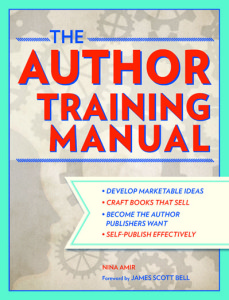by Nina Amir, @NinaAmir
There are many reasons for novelists to enter the realm of nonfiction. However, moving into this unknown territory can feel hard and scary, especially for those who like to write fiction by the seat of their pants. For planners, it’s not quite so difficult.
Even though by nature I’m a seatser, I’m a huge advocate of planning. The reason why is simple: Planning helps a book succeed—no matter the genre. It provides a writing guide for a marketable book.
Here are four steps to take to plan out your nonfiction book and end up with a guide to take you from start to finish.
Step 1: Decide why you want to write your nonfiction book. It’s always important to be clear about your goals. You want your book to help you accomplish them. Will your book help you sell your fiction? Do you just want to write something different? Do you want to build a business around your book? I suggest you write nonfiction that dovetails with your fiction in some way to help you create a successful writing career. In this way you can create a brand that works for all the books you write. Also, be sure the book you write fulfills your purpose, whatever that may be.
Step 2: Create a business plan for your book. This is where the planning comes in. A business plan for a book follows the format of a book proposal. It’s only a proposal if you propose the plan to a publisher, and even a publisher considers a proposal a business plan. If you self-publish, this is your business plan.
Going through the process of accumulating the information for a business plan will help you:
- Determine if your idea has a high likelihood of selling.
- Craft your idea into a marketable book.
- Hone your idea into one that is unique in its category.
- Polish your idea into one that is necessary in the marketplace and in the category.
Accomplish all of this by conducting a market and competitive analysis and then retooling your idea based upon this information. (I suggest that you accumulate all the information necessary for a business plan at some point. You can learn more about this process in my book, The Author Training Manual: Develop Marketable Ideas, Craft Books That Sell, Become the Author Publishers Want, and Self-Publish Effectively.)
When you have finished these two sections of your business plan, complete three more sections:
- The Overview: This is a brief summary of your book (a paragraph or two) that reads like back-of-the-book copy. It also includes a pitch for your book, a 75-word (or so) elevator speech. Mention just after this the length of your final manuscript, any backmatter, illustrations, special features, etc., you plan to include. Also compile a list of benefits—the value you will provide to readers.
Now you have a clear picture of what you plan to write. You really know what you are writing about.
- The List of Chapters: This is your table of contents. When you are done with the overview, do a mind mapping exercise or simply brainstorm all the ideas you might have about content for your book. Throw it all out there on a white board, poster board or computer mind mapping program. Don’t stop until you run out of ideas.
Then organize this information into chapters. You likely will end up with major subjects, those that are obviously chapters, and minor ones that go with the major ones. The minor topics can become subheadings in your chapters.
Type this up into a table of contents for your book.
- The Chapter Summaries: It’s now time to flesh out your idea with a chapter-by-chapter synopsis. For each one of your chapters, write a paragraph or two describing the content. This will help you remember exactly what you plan to write.
Review all your material and evaluate if the book you have planned accomplishes your Step 1 goals. Also evaluate if it is unique in its category as well as necessary in its category and market based on the information you accumulated in Step 2.
Step 3: Create a Writing Guide
Create a two-step writing guide based on the work you have done previously. Use it to write a marketable book and one that fulfills your goals—the reason you want to write nonfiction.
- Create a computer folder called “[Your Book Title] Writing Guide.” Place within it:
- The Overview of your book (from your book’s business plan).
- The List of Chapters.
- The Chapter Summaries.
- Create individual chapter documents for all the chapters in your book and place them in the “[Your Book Title] Writing Guide” folder. Open a document for each chapter. Copy and paste that chapter’s summary into the document twice. Leave the first summary intact. Break the second duplicate summary into bullet points or subheadings with spaces in between. Each sentence might become a bullet point or subheading, for example. (If you find it easier, determine what questions you need to answer, what benefits you need to provide, or what solutions your need to provide to address the topics about which you need to write.)
Step 4: Write Your Book
To write your book, open the writing guide and review the first three documents.This reminds you of the book you want to create and helps you stay focused on your idea and the promises you want to keep to readers. In particular, read the pitch to stay focused on your book’s topic and on the unique and necessary angle. Refer to this anytime you feel lost, stuck, or off track. Refer back to the list of benefits to remind yourself of the value readers expect from your book and to be sure you deliver it.
Compose your manuscript using the bulleted chapter summaries. Open a chapter document. Review the complete summary at the top to remind yourself of that particular chapter’s content. Then, write your chapter by moving from bullet point to bullet point, section to section, subhead to subhead, until you get to the end of your chapter. Write in the space underneath each bullet point.
Although the planning process takes some time, you will find that you can write your nonfiction books easily and efficiently using this process. Apply it to fiction and you’ll have the same results.
Nina Amir, author of How to Blog a Book: Write, Publish, and Promote Your Work One Post at a Time and The Author Training Manual: Develop Marketable Ideas, Craft Books That Sell, Become the Author Publishers Want, and Self-Publish Effectively, transforms writers into inspired, successful authors, authorpreneurs and blogpreneurs. Known as the Inspiration to Creation Coach, she moves her clients from ideas to finished books as well as to careers as authors by helping them combine their passion and purpose so they create products that positively and meaningfully impact the world. A sought-after author, book, blog-to-book, and results coach, some of Nina’s clients have sold 300,000+ copies of their books, landed deals with major publishing houses and created thriving businesses around their books. She writes four blogs, self-published 12 books and founded National Nonfiction Writing Month, aka the Write Nonfiction in November Challenge.
To learn more about Nina, visit www.ninaamir.com. Get a FREE 5-Day Become a Published Author Series from her when you click here.

I admire anyone who can write non-fiction. I wouldn’t know what to write about. A book on blogging? Chapter One – Clones…
Do you write fiction now, Alex? Tie into your themes and subjects!
Hey! I love how thorough this is. Excellent. I have a notion for a non-fiction but it will have to wait in the cue. My sister-in-law had a book published last year using very similar steps. I am excited that you discuss mind-mapping. I use it for just about everything but never on a computer – have to colour and draw and spread out. I use the Tony Buzan way of doing mind-maps and have taught the method to others. Thanks for a great piece. I’ll be visiting your blogs…
And thanks Elizabeth for another great hosting job.
Jan,
Thanks for your comment. I used to use sticky notes…love that. Now I use Freemind. And I use it for everything…even my to-do lists!
Let me know if you cross over to nonfiction!
Elizabeth – Thanks for hosting Nina.
Nina – Thanks for sharing your ideas. Writing non-fiction really does require different sorts of planning and marketing and so on. So I agree completely that it takes some work and strategy to make that transition. But having done both, I think it also give you versatility.
Margot,
Thanks for your comment. I’ve only written one long nonfiction piece (that needs some work yet), but I think the planning is a bit different–but necessary for both. I think fiction authors can benefit from crossing over in terms of branding and income. Nonfiction authors can learn a lot about craft from fiction authors.
Oh, interesting. I don’t feel like I’m expert enough in anything that someone would want to read a book I wrote on a non-fiction topic, but I’ve toyed a little with the idea of something a bit sillier (which goes with my online persona). Good to have a roadmap!
Often you can bring in experts or interview the, Hart. Keep that in mind, but even a short nonfiction piece to use for a mailing list opt-in works!
Thanks, Nina and Elizabeth, another keeper (for me). Writing non-fiction does require a different thought process.
It’s funny because I started out writing non-fiction. Loved it! It was mostly magazine articles for kids. For me, expanding into fiction was a huge leap. Thanks for the great tips!
I wrote lots of fiction in grade school. My novel…still in process…was a huge leap for me as well. I’m trained as a magazine journalist. Thanks for your comment, Julie.
I love writing non-fiction. Both of my books tie in with my speaking platform.
That’s a great reason to write nonfiction, L. Diane! And novelists who cross over to nonfiction will find themselves with many more opportunities to speak–and sell books at the back of the room.
Nina–Thanks so much for guest posting today. I like the way you’ve outlined a plan for approaching non-fiction. It can seem so intimidating to change course and you’ve made the process a lot more concise.
You are welcome, Elizabeth! I hope the post encourages some fiction writers to try their hands at nonfiction or simply gets some nonfiction writers going.